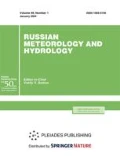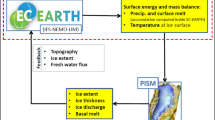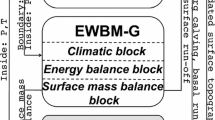Abstract
Currently, the Earth system models are widely used for studying present-day climate dynamics and for palaeoreconstructions. A full Earth system model should include dynamical ice sheet models of Greenland and Antarctica as subsystems. To couple the latters with the atmospheric and with the oceanic blocks, it is necessary to introduce a special procedure to sustain mutual data exchange between subsystems with different temporal and spatial scales. In this paper, we give a brief description of the blocks of the Earth system model developed in the Institute of Numerical Mathematics of RAS (INMCM). On the basis of the previous studies aimed at examination of sensitivity of the cryospheric block of the model to variations in the key model parameters, we carried out numerical experiments to prove stability of the model climate and to establish equilibration time of the Greenland ice sheet to the conventional pre-industrial climate. It was confirmed that our Earth System Model with the interactively and asynchronously coupled Greenland ice sheet model simulates stationary climate. Equilibration time of the Greenland ice sheet is nearly 20 thousand model years. It was demonstrated that the values of calculated surface mass balance and its components correspond to similar model results described in the literature.
Similar content being viewed by others
References
V. A. Alekseev, E. M. Volodin, V. Ya. Galin, et al., The Modeling of Present-day Climate Using Atmospheric Model of INMRAS, Preprint of INM No. 2086-B98 (INM, Moscow, 1998) [in Russian].
V. V. Alekseev and V. B. Zalesny, “The Numerical Model of the Large Scale Dynamics of the Ocean,” in Computational Processes and Systems, Ed. by G. I. Marchuk (Nauka, Moscow, 1984), No.10.
A. V. Bagno, R. V. Garaschyuk, and V. B. Zalesny, “A Model of the Large-scale Ocean Circulation and Sea Ice Evolution,” Okeanologiya, No. 2, 36 (1996) [Oceanology, No. 2, 36 (1996)].
E. M. Volodin and N. A. Diansky, “Responce of a Coupled Atmosphere-Ocean General Circulation Model to Increased Carbon Dioxide,” Izv. Akad. Nauk, Fiz. Atmos. Okeana, No. 2, 39 (2003) [Izv. Atmos. Ocean. Phys., No. 2, 39 (2003)].
E. M. Volodin and V. H. Lykossov, “Parameterization of Heat and Moisture Transfer in a Soil-vegetation System for Use in Atmospheric General Circulation Models. 1. Formulation and Simulations Based on Local Observational Data,” Izv. Akad. Nauk, Fiz. Atmos. Okeana, No. 4, 34 (1998) [Izv. Atmos. Ocean. Phys., No. 4, 34 (1998)].
V. Ya. Galin, “Parameterization of Radiative Processes in the DNM Atmospheric Model of INM,” Izv. Akad. Nauk, Fiz. Atmos. Okeana, No. 3, 34 (1998) [Izv. Atmos. Ocean. Phys., No. 3, 34 (1998)].
N. A. Diansky, A. V. Bagno, and V. B. Zalesny, “Sigma-model of Global Ocean Circulation and Its Sensitivity to Variations in Wind Stress,” Izv. Akad. Nauk, Fiz. Atmos. Okeana, No. 4, 38 (2002) [Izv. Atmos. Ocean. Phys., No. 4, 38 (2002].
N. A. Diansky and E. A. Volodin, “Simuiation of Present-day Climate with a Coupled Atmosphere-Ocean General Circulation Model,” Izv. Akad. Nauk, Fiz. Atmos. Okeana, No. 6, 38 (2002) [Izv. Atmos. Ocean. Phys., No. 6, 38 (2002].
O. O. Rybak and E. M. Volodin, “Applying the Energy-and Water Balance Model for Incorporation of the Cryospheric Component into a Climate Model. Part I. Description of the Model and Computed Climatic Fields of Surface Air Temperature and Precipitation Rate,” Meteorol. Gidrol., No. 11 (2015) [Russ. Meteorol. Hydrol., No.11, 40 (2015)].
O. O. Rybak, E. M. Volodin, and A. P. Nevecherja, “Geothermal Heat Flux in Greenland and Its Influence upon the Model Ice Sheet Topography,” Led i Sneg, No. 4, 55 (2015) [in Russian].
O. O. Rybak, E. M. Volodin, A. P. Nevecherja, and P. A. Morozova, “Applying the Energy-and Water Balance Model for Incorporation of the Cryospheric Component into a Climate Model. Part II. Modeled Mass Balance on the Greeni and Ice Sheet Sur face,” Meteorol. Gidrol., No. 6, 41 (2016) [Russ. Meteorol. Hydrol., No. 6, 41 (2016)].
O. O. Rybak, E. M. Volodin, A. P. Nevecherja, et al., “Calculation of Mass Discharge of the Greenland Ice Sheet in the Earth System Model,” Led i Sneg, No. 3, 56 (2016) [in Russian].
N. G. Yakovlev, “Coupled Model of Ocean General Circuiation and Sea Ice Evoiution,” Izv. Akad Nauk, Fiz. Atmos. Okeana, No. 3, 39 (2003) [Izv. Atmos. and Oceanic Physics, No. 3, 39 (2003)].
J. Adem, “Numerical Simulation of the Annual Cycle of Climate during the Ice Ages,” J. Geophys. Res., 86 (1981).
A. Arakawa and V. Lamb, “Computational Design of the Basic Dynamical Processes of the UCLA General Circulation Model,” in Methods in Computational Physics, Ed. by J. Chang, Vol. 17 (Academic Press, San Francisco, 1977).
J. L. Bamber, S. Ekholm, and W. B. Krabill, “A New, High Resolution Digial Elevation Model of Greenland Fully Validated with Airborne Laser Altimeter Data,” J. Geophys. Res., 106 (2001).
A. K. Betts, “A New Convective Adjustment Scheme. Part I. Observational and Theoretical Basis,” Quart. J. Roy. Meteorol. Soc., 112 (1986).
J. Ettema, M. R. van den Broeke, E. van Meijgaard, and W. J. van de Berg, “Climate of the Greenland Ice Sheet using a High-resolution Climate Model. Part 2: Near Surface Climate and Energy Balance,” The Cryosphere, 4 (2010).
R. S. Fausto, A. P. Ahlstrom, D. van As, et al., “A New Present-day Temperature Parameterization for Greenland,” J. Glaciology, 55 (2009).
W. L. Gates, “The Numerical Simulation of Ice-age Climate with a Global General Circulation Model,” J. Atmos. Sci., 33 (1976).
C. O. Hines, “Doppler Spread Parameterization of Gravity Wave Momentum Deposition in the Middle Atmosphere, Part 2: Broad and Quasimonochromatic Spectra, and Implementation,” J. Atmos. and Solar-Terrestrial Phys., 59 (1997).
P. Huybrechts, “Sea-level Changes at the LGM from Ice-dynamic Reconstructions of the Greenland and Antarctic Ice Sheets during the Glacial Cycles,” Quart. Sci. Rev., 21 (2002).
T. N. Palmer, G. J. Shutts, and R. Swinbank, “Alleviation of a Systematic Westerly Bias in General Circulation and Numerical Weather Prediction Models through an Orographic Gravity Wave Drag Parameterization,” Quart. J. Roy. Meteorol. Soc., 112 (1986).
A. Rob in son, R. Calov, and A. Ganopolski, “An Efficient Regional Energy-moisture Balance Model for Simulation of the Greenland Ice Sheet Response to Climate Change,” The Cryosphere, 4 (2010).
K. M. Terekhov, E. M. Volodin, and A. V. Gusev, “Methods and Efficiency Estimation of Parallel Implementation of the a-model of General Ocean Circulation,” Russ. J. Numer. Analysis and Mathematical Modelling, No. 2, 26 (2011).
M. van den Broeke, J. Bamber, J. Ettema, et al., “Partitioning Recent Greenland Mass Loss,” Science, 326 (2009).
Author information
Authors and Affiliations
Corresponding author
Additional information
Original Russian Text © O.O. Rybak, E.M. Volodin, P.A. Morozova, P. Huybrechts, 2018, published in Meteorologiya i Gidrologiya, 2018, No. 2, pp. 5–16.
About this article
Cite this article
Rybak, O.O., Volodin, E.M., Morozova, P.A. et al. Equilibrium State of the Greenland Ice Sheet in the Earth System Model. Russ. Meteorol. Hydrol. 43, 63–71 (2018). https://doi.org/10.3103/S1068373918020012
Received:
Accepted:
Published:
Issue Date:
DOI: https://doi.org/10.3103/S1068373918020012




